
Drawing of mature trees, foliage, and cones [Matt Strieby, 2019.11].

A beautifully formed mature tree, 40 m tall, Haney Meadows, Washington [C.J. Earle, 2007.07.22].
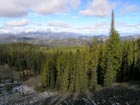
Forest near Swauk Pass, Washington, dominated by Larix occidentalis in the company of, mostly, Picea engelmannii and Abies lasiocarpa [C.J. Earle, 2007.10.06].
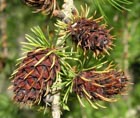
Twig with nearly-mature female cones [C.J. Earle, 2007.06.17].
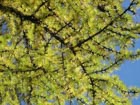
Branch with autumn foliage; note the short shoots [C.J. Earle, 2007.10.07].

Bark of a tree about 60 cm dbh, Haney Meadows, Washington. Lichen is Letharia vulpina [C.J. Earle, 2003.08.15].
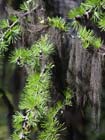
Foliage of a mature tree, Haney Meadows, Washington. Lichen is Bryoria sp. [C.J. Earle, 2003.08.15].
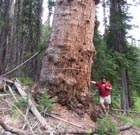
"Big Tree Bob" Van Pelt measuring the largest recorded specimen, the Cliff Creek Colossus, in the Wallowa Mountains. Sadly, this tree had died the year before [C.J. Earle, 2008.07.21].
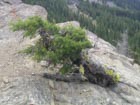
A rare example of a krummholz tree (ca. 1 m tall); Mission Ridge, Washington [C.J. Earle, 2007.07.22].
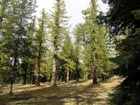
Judy's Tamarack Park, an old-growth larch forest in Washington that has been restored through fuels control and prescribed fire [C.J. Earle, 2007.10.07].

Conservation Status

Larix occidentalis
Nuttall 1849
Common names
Western larch, western tamarack, hackmatack (Peattie 1950), mountain larch (Parish et al. 1996), mélèze occidental (Parker 1993).
Taxonomic notes
Described in 1806 by Lewis and Clark but not recognized as a distinct species until 1849, when described by Thomas Nuttall (Parish et al. 1996). Several studies have examined hybridization with Larix lyallii (Carlson 1965, Carlson et al. 1991, Knudsen 1968).
Description
Trees to 50 m tall; long clear trunk to 200 cm dbh; crown short, conic. Bark thin and scaly when young, becoming thick (to 15cm), plated, deeply furrowed, reddish brown when older. Branches horizontal, occasionally drooping in lower crown of open-grown trees; twigs orange-brown, initially pubescent, becoming glabrous or very sparsely pubescent during first year. Buds dark brown, generally puberulent, scale margins erose. Needles of short shoots 2-5 cm × 0.65-0.80 mm, 0.4-0.6 mm thick, keeled abaxially, with shallow convex midrib adaxially, soft, pale green, turning bright yellow in autumn, in circular clusters of 15-30 on spur twigs and singly along current year's growth; resin canals 20-50 µm from margins, each surrounded by 5-7 epithelial cells. Seed cones oval when closed, ovoid when open, 2-3 × 1.3-1.6 cm, on curved stalks 2.5-4.5 × 3.5-5 mm; scales 45-55, margins entire, adaxial surface pubescent; bracts tipped by awn to 3 mm, exceeding scales by ca. 4 mm. Pollen 71-84 µm diam. Seeds reddish brown, body 3 mm, wing 6mm. 2n=24 (Parish et al. 1996, Parker 1993). See García Esteban et al. (2004) for a detailed characterization of the wood anatomy.
Distribution and Ecology
Canada: British Columbia; USA: Montana, Idaho, Washington and Oregon at 500-2135 m, usually in mountain valleys and lower slopes (Parker 1993). See also (Thompson et al. 1999). Hardy to Zone 4 (cold hardiness limit between -34.3°C and -28.9°C) (Bannister and Neuner 2001).
Distribution data including polygons provided by USGS (1999) and my personal observations through 2017. Green is Larix lyallii; red is L. occidentalis.
Remarkable Specimens
Both the largest and oldest known trees are from Seeley Lake, Montana. The largest tree is the Seeley Lake Giant, on Seeley Lake near Paxton Camp, Lolo National Forest, Montana. It has a stem volume of 83 m3, dbh 221 cm, height 49.4 m. Nearly as large is the Burnt Corral Larch, near Starkey Experimental Forest in Oregon, has a stem volume of 78 m3, dbh 209 cm, height 39.6 m.
The tallest known tree, 64.9 m, was measured by Elijah Whitcomb using a laser, sine method. It occurs at Pleasant Valley Campground, Okanogan-Wenatchee National Forest, Washington (NTS post 2020). This has been one of the tallest known for many years, and it kept growing, eventually setting the record. A former height champion grows near Green Creek in Umatilla National Forest, Oregon. It stands 58.5 m tall with a dbh of 138 cm (Van Pelt 2000). Canada has some huge trees; one near Bridesville, BC is 52.4 m tall, 194 cm in diameter, and has a crown spread of 11.9 m (S. Bednarski e-mail 2012.06.15).
Alas, this this another one of those species for which the greatest groves fell to the axe and saw. There are historic reports of trees up to 65 m tall and 250 cm dbh (S. Bednarski e-mail 2012.06.15).
The oldest recorded specimen is 824 years, crossdated, for sample SL0404 collected by Steve Voelker and Lara Läubli in the Strawberry Mountains of Oregon (Brown 2025). An age of 920 years, based on a ring-counted stump, is reported for a tree at Seeley Lake, Montana (Koch 1945). The datum was collected by Ehlers Koch, one of the foremost forest scientists of his time, and is very credible. Arno (2010) believes some living trees in this stand exceed 1,000 years of age, and it does not seem unreasonable. There is also 920-year ring count from a stump in a clearcut near Cranbrook, BC (Stoltmann 1993). This may be the same tree reported by Flynn and Holder (2001) as having 915 rings.
Ethnobotany
It produces a sweet gum that hardens when exposed. Native peoples would chew this gum for its sugar (galactan, which tastes like a slightly bitter honey), thought to have medicinal qualities. Today, trees are sometimes tapped for a sap that can be dried to a syrup and then mixed with sweeteners. It is currently one of the most valuable timber-producing species in western North America, where its close-grained, durable wood is used in framing, railway ties, pilings, exterior and interior finishing work, pulp and as firewood. The bark contains Arabino galactan, a water-soluble gum used for offset lithography and in pharmaceuticals, paint and inks (Parish et al. 1996, Parker 1993).
Observations
A fairly common tree in montane forest of the eastern Cascades (Washington) and the Blue Mountains (Washington and Oregon). The finest stands I have seen are on the shores of Seeley Lake, Montana; the locale, which includes the largest known specimen of western larch, is described in detail by Arno and Hammerly (2007). This is a flat site, very high productivity, with spatially continuous stands of trees over a meter in diameter and up to 50 m tall. A very close second is "Judy's Tamarack Park" in the eastern Wenatchee Mountains of Washington, at about latitude 47.22° N, longitude 120.37° W. The trees here are not quite as large (up to 150 cm dbh) or as tall (mostly about 30 m) but the site probably has some of the oldest individuals to be found in the species, with bark up to 30 cm thick and very tight ring structure; we counted a few and found them to be uniformly more than 400 years old. Both stands were formerly deprived of their natural fire regime by Smokey the Bear and as a result were thick with ingrowth of species such as Abies lasiocarpa, Pinus contorta and Pseudotsuga menziesii, ripe for a crown fire that would have destroyed these magnificent old trees. However, both stands have recently (as of 2007) been cleared of their undergrowth and are being returned to a regime of frequent, low-intensity prescribed fire that may keep them safe for a long time yet.
Remarks
Western larch is widespread in mixed upland stands. It prefers north exposures although it is very shade-intolerant. The thick bark and early self-pruning of mature trees make it fire tolerant, permitting it to live for centuries and attain very large sizes; it is the largest of all larches. Larch seeds germinate and grow readily on recently burned soils. Fire production and selective logging, along with its shade intolerance, have reduced the abundance of this larch in many managed forests. The larch casebearer, Coleophora laricella, is an introduced European insect pest that feeds on young foliage and has further contributed to the decline of this species (Parish et al. 1996).
Citations
Arno, Stephen F. and Ramona Hammerly. 2007. Northwest Trees, second edition. Seattle, WA: Mountaineers Books. 258 pp.
Arno, Stephen F. 2010. The Seeley Lake larch. Forest History Today Spring/Fall 2010, pp. 13-19.
Brown, Peter. 2025. OLDLIST, a database of old trees. https://www.rmtrr.org/oldlist.htm, accessed 2025.03.01.
Flynn, James H., Jr. and Charles D. Holder. 2001. A Guide to the Useful Woods of the World, 2nd ed. Forest Products Research. ISBN=1892529157 (page 318).
Koch, Ehlers. 1945. The Seeley Lake tamaracks. American Forests 51(1):21, 48.
Nuttall, Thomas. 1849. North American Sylva, vol. 3. (p. 143, plate 120) Read it (pdf file opens in new window).
See also
Arno, Stephen F. and J.R. Habeck. 1972. Ecology of alpine larch (Larix lyallii Parl.) in the Pacific Northwest. Ecological Monographs 42(4): 417-450.
Elwes and Henry 1906-1913 at the Biodiversity Heritage Library (Photo). This series of volumes, privately printed, provides some of the most engaging descriptions of conifers ever published. Although they only treat species cultivated in the U.K. and Ireland, and the taxonomy is a bit dated, still these accounts are thorough, treating such topics as species description, range, varieties, exceptionally old or tall specimens, remarkable trees, and cultivation. Despite being over a century old, they are generally accurate, and are illustrated with some remarkable photographs and lithographs.
FEIS database.
Owens and Simpson 1986.










